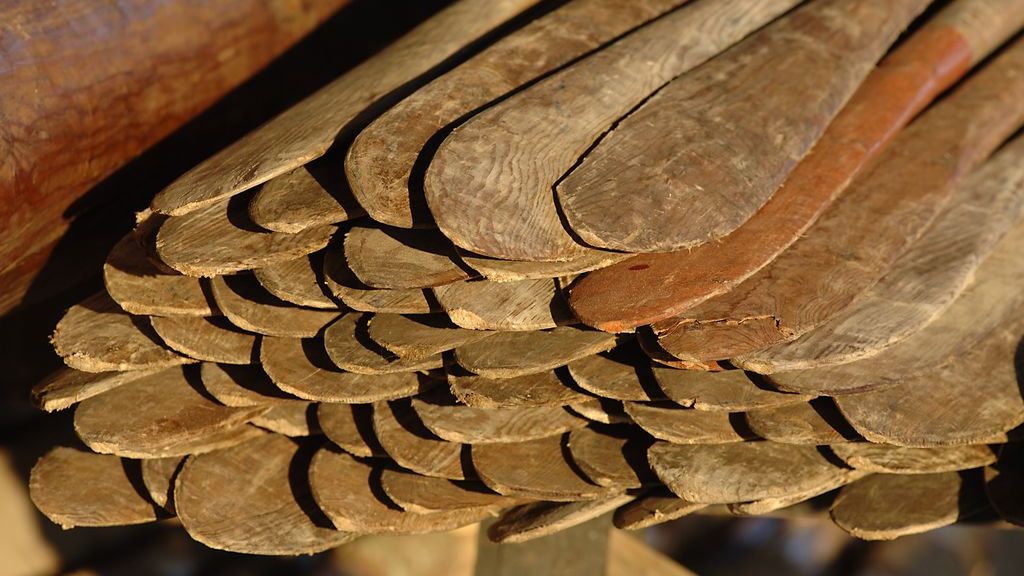Silas Tavs Ravn shows a group of secondary school students from Rosenkilde School what Viking 'rainwear' looked like. In other words, the clothes the Vikings wore when they were at sea. The children are allowed to pour water on the clothes to see how it bounces off and compare it to modern rainwear.
Silas also shows the group of students the coverall that museum workers wear when they go on longer voyages with the ships. It is a modern survival suit that fits tightly around the body and keep you warm. It ensures that you don't die from hypothermia if you fall into the water in rough weather. One of the students raises his hand when Silas asks, if anyone would like to try on the suit. The secondary school student puts on the suit and shows it to the students. Silas then doesn’t give it much more thought.
- "Next time the students visited the Museum I am told that this particular student actually wears the same clothes every day. He has two pairs of each outfit. Two T-shirts, two sweaters, two trousers, and when one outfit is in the laundry, he wears the other outfit which is completely similar. So, he usually can't stand the fact of clothes being different," says Silas Tavs Ravn who has a special responsibility for craft activities
public activities and education at the Viking Ship Museum.
Development in quantum leaps
A child with an autism diagnosis perceives the world differently compared to most other children. For such a child a museum can be an incredibly chaotic place. It is difficult to decode the rooms and figure out what is allowed or not allowed.
The National Board of Social Affairs and Health in Denmark estimates that almost 2% of children and young people aged 0-17 have an autism diagnosis. Regardless of whether we have children with or without diagnoses visiting the museum, it is our task to push the students’ boundaries a little bit so they leave with a new perspective. On a daily basis the museum educators experience students who visit the Museum get a boost of courage and achieve things they never thought they could.
- "But it’s actually huge when a student whose boundaries can be very difficult to change on a daily basis visits us and he undertakes such a quantum leap. His comfort zone has actually been broken 10 years ago," explains Silas Tavs Ravn.
The setting means everything
When planning education targeting students from a school for children with special needs the content of the Museum activities does not change much. Our experience tells us that it is much more important to focus on the setting around the activities and content. It is important to have a clear structure, visualization and give the children an opportunity to withdraw. In addition to this it has made a significant difference for the children when the museum's educators take time to create personal relationships with the children.
"What we take away from this project is that all communication and teaching should really be organized with the same clarity and structure. Whether you are an adult, a tourist or a schoolchild it is easier to receive information if it is given in a clear and comfortable way," says Silas Tavs Ravn.
When the setting is in place and the pupils feel safe we have seen some really great things unfold says Kathrine Noes Sørensen, team leader for the School Service at the Viking Ship Museum. She has been responsible for developing the program for the children from Rosenkilde School.
- "We are actually pushing forward a real difference regarding their development. At least for some of the pupils. It's not something we can measure but we know from the teachers that some of the pupils have exceeded some of the limits they normally had. If they normally can't slide down a slide, they can suddenly go down in a boat. We have also seen that some of those who may be afraid of communities they actually enjoy working together with others to pull a boat. They experience social settings and teamwork that actually feel really good," she explains.
Selected experiences for inspiration
• Send a photo, name and short presentation of the Museum Educator before the visit
• Start and end each visit in the same way
• Use the first half hour to meet the students in a more informal activity
• Use pictograms with pictures throughout the entire day
• Visualize all the locations of the day. Dining room, classroom, etc.
• Clearly indicate and visualize where it is possible to retreat for a break
• Visualize the activity itself and all sub-processes
• Make sure that all needs are met before the class starts
Social settings become less dangerous
Kathrine Noes Sørensen and Silas Tavs Ravn have made a point of choosing activities that support and strengthen the feeling of togetherness when organizing courses for students from Rosenkilde School. The students will for example row one of the boats together in rhythm, or work together to pull a 25-tonne Viking ship through the water.
One of the most difficult things for children with a diagnosis is to be part of social structures and communities. Many children with diagnoses have repeatedly experienced not succeeding in social contexts and therefore the Museum's Educators have paid extra attention to the social environment.
- "As Museum Educators we are used to the fact that when someone comes to the Museum they have to hear and see and do what we have planned. And that's just not necessarily the case with this group. I've tried to do some teaching where we had to stop the activities half an hour prior to planned, because there was just no more energy. And then it should be possible to interrupt the teaching immediately," says Kathrine Noes Sørensen.
The collaboration with The Autism Centre West Zealand and Rosenkilde School ended at the beginning of 2023. We are now continuing the work by using pictograms more actively in all our teaching situations and creating a predictable structure that benefits all students.
Facts about the School Service
• The School Service is a national knowledge Centre for external learning environments anchored in the Children and Youth Administration in the City of Copenhagen
• For more than 40 years the school Service has worked with schools and cultural institutions across the country to develop professional learning environments
• The Viking Ship Museum collaborates with the School Service on academic, creative and crafts programmes for school children
• In teaching at the Viking Ship Museum we take an enquiry-based approach to history. Our starting point is the children's and students' curiosity about the Viking Age and Denmark's maritime history.
» Read more about all our educational programmes and activities for school children here...
![[Translate to english:] Silas Tavs Ravn er formidlingsmedarbejder med særligt ansvar for håndværksformidling. Han har været den primære underviser i forløbene med eleverne fra Rosenkilde Skole under Autismecenter Vestsjælland. [Translate to english:] Silas Tavs Ravn er formidlingsmedarbejder med særligt ansvar for håndværksformidling. Han har været den primære underviser i forløbene med eleverne fra Rosenkilde Skole under Autismecenter Vestsjælland.](/frontend/_processed_/d/3/csm_2015_05_27_15_41_56_WK_dced7d341c.jpg)



![[Translate to english:] Silas Tavs Ravn er uddannet skovarbejder fra skovskolen og har en kandidat i filosofi. [Translate to english:] Silas Tavs Ravn er uddannet skovarbejder fra skovskolen og har en kandidat i filosofi.](/frontend/_processed_/9/0/csm_2018_09_19_14_40_53_WK_663ea23b0b.jpg)